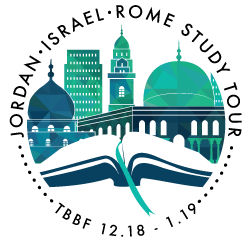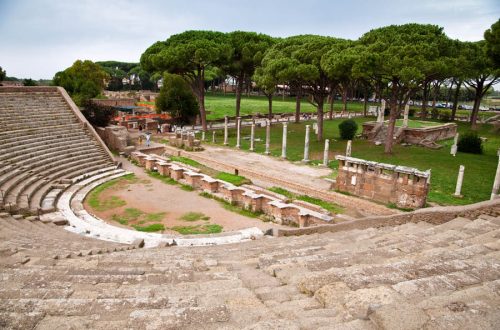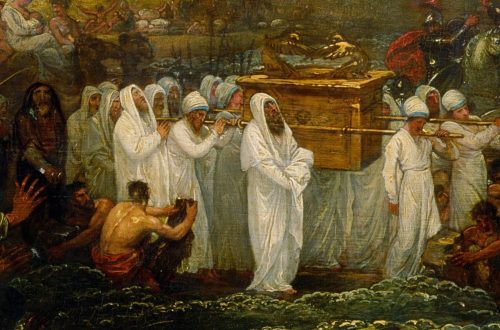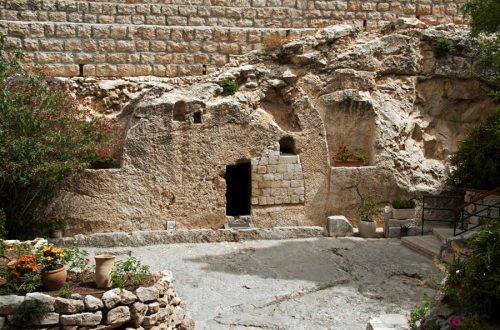Hazor

The tell of Hazor is today the largest archaeological site in Israel at 200 acres. It was an ancient Canaanite and Israelite city located in the upper Galilee region of Israel, assigned to the tribe of Naphtali (Josh 19:36).
Located along the route from Damascus to Megiddo, Hazor had strategic importance. The earliest reference to Hazor dates to the late 19th or 18th century BC. It may have supported a population of 40,000 during the Bronze Age.
The Bible first introduces Hazor in the context of Israel’s conquest of Canaan. Joshua 11:10 refers to Hazor as “The head of all those kingdoms”. The Israelites defeated the Canaanites, killed Jabin, and burned the city to the ground.
But during the time of the judges, Hazor is back in control of Hazor under the leadership of Jabin king of Canaan. Judges 4 records the story of Deborah and Barak who defeat this army nine hundred iron chariots.
Hazor became an important Israelite city during Solomon’s reign, as Solomon built up garrison cities and strategic bases. Hazor, Megiddo, and Gezer were the most important of these cities (1 Kgs 9:15). The last historical reference to Hazor indicates that the city fell to Assyria in 732 BC, along with other cities in the northern kingdom of Israel (2 Kgs 15:29).
Archaeologists have uncovered a six-chambered gate at Hazor, which is nearly identical in size and design to gates at Megiddo and Gezer. These gates are a remarkable testimony to Solomon’s building activity as described in 1 Kings 9:15.
Tel Dan
The last chapters of Judges show Samson of the tribe of Dan fighting the Philistines. Eventually Dan migrated to the north and was able to take a city called Laish. They renamed the city Dan and settled in the area around it. Dan was always a small tribe, and it never exercised significant influence in Israel.
The biblical city of Dan is often mentioned in the description of the land of Israel, namely “from Dan even to Beersheba” (Judg. 20:1). The tell, which covers about 50 acres, is situated at the northern end of the richly fertile Huleh Plain at the base of Mount Hermon. The abundant springs of the site provide one of the three main sources of the Jordan River. The city was formerly named Laish (Judg. 18:7, or Leshem in Josh. 19:47) when occupied by the Canaanites.
Following the establishment of the Israelite kingdom under David and Solomon, Jeroboam led the Northern tribes in revolt against Rehoboam (about 925 B.C.). As an alternative to worship in Jerusalem, Dan and Bethel were fortified as border fortress/sanctuaries (1 Kings 12:29) with temples containing golden calf representations of Yahweh. This may have represented a combination of Baal worship with worship of Yahweh. The extent to which the Baal cult influenced Northern Israel is seen in the reign of Jehu, who did not destroy the altars at Dan and Bethel, despite eradicating the Baal priests from the land (2 Kings 10:23–29).
Excavations at Dan have uncovered the “high place” of Jeroboam along with a small horned altar, the city gate (with royal throne) and walls (12 feet thick), hundreds of pottery vessels, buildings, and inscribed objects.
This city was soon taken by Ben-hadad of Aram and then recaptured by Jeroboam II in the eighth century B.C. (2 Kings 14:25). The Israelite city of Dan fell to the Assyrians under Tiglath-pileser III (Pul of OT) about 743 B.C. (2 Kings 15:29). He annexed the city into an Assyrian district. Many Danites were deported to Assyria, Babylon, and Media following the fall of Samaria in 722 or 721 B.C. (2 Kings 17:6) to Sargon II. Foreigners were brought in from Babylon, Aram, and other lands to settle Israel’s territory.
The writer of Kings ascribed the fall of the kingdom to the worship of gods other than Yahweh (2 Kings 17:7–20), and Dan was one of the key centers of this idolatry. As Josiah came to the throne of Judah in 639 B.C., Assyria was on the decline. Josiah incorporated the former Northern Kingdom territories into a united country, restoring the classical borders of Israel to “from Dan to Beersheba.” An upper gate to the city was built during this period, and the inscription found at this level, “belonging to Ba’alpelet,” demonstrates that Baal worship continued to influence this area after the Assyrian destruction. The partially rebuilt city survived until the onslaught of the Babylonian army of Nebuchadnezzar (about 589 B.C.; cp. Jer. 4:14–18).
(by R. Dennis Cole, Holman Illustrated Bible Dictionary)
Caesarea Philippi
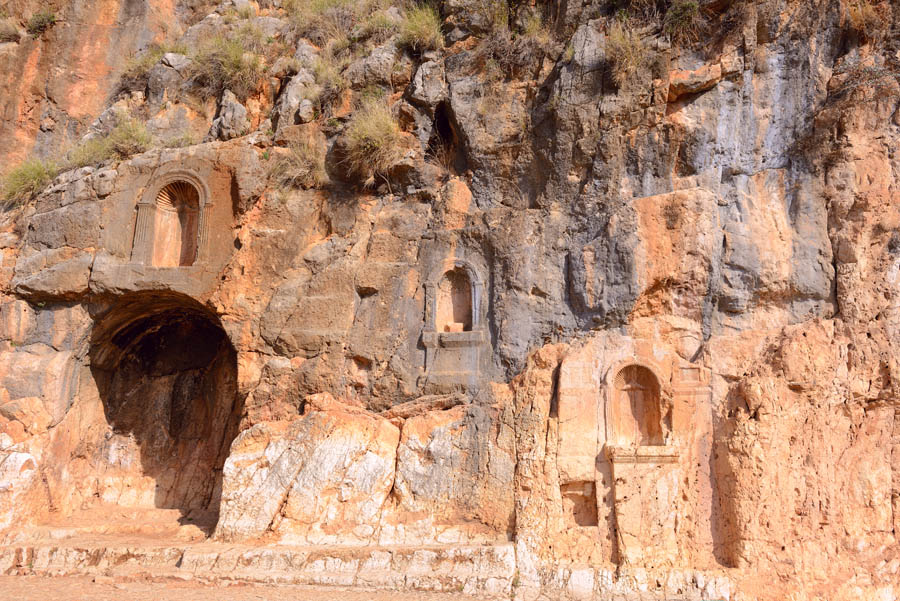
Situated 25 miles north of the Sea of Galilee and at the base of Mt. Hermon, Caesarea Philippi is also the location of one of the largest springs feeding the Jordan River. This abundant water supply has made the area very fertile and attractive for religious worship. Numerous temples were built at this city in the Hellenistic and Roman periods. Apparently known as Baal Hermon and Baal Gad in the Old Testament period, this site later was named Panias after the Greek god Pan who was worshiped here. There is no record of Jesus entering the city, but the great confession and the transfiguration both occurred in the vicinity of the city, then known as Caesarea Philippi. Matt. 16:13; Mark 8:27
During the Jewish-Roman War of a.d. 66–70, the Roman general Vespasian rested his army here. After the war, Titus, who succeeded his father as general of the Roman armies, held gladiatorial shows here during which a number of Jewish prisoners were put to death. After subduing the Jews, the Romans changed its name back to Paneas. (W.T. Edwards Jr. – Holman Illustrated Bible Dictionary)
Golan Heights

An area of highlands, mountains, and volcanic ash cones northeast of the Sea of Galilee; composed of the regions previously called Bashan, Karnaim, and Gaulanitis. A refuge city called Golan was located in Bashan (Deut 4:43; Josh 20:8; 21:27; 1 Chr 6:71).
The region has been called the Golan Heights only since the 19th century. The Golan Heights has been inhabited and fought over for millennia. The area provides 15 percent of modern Israel’s water supply. Israel regained control of the Golan Heights from Syria during the Six Day War of 1967. (R.L. Drouhard – Lexham Bible Dictionary)
Bethsaida
Bethsaida was a fishing village located on the northern shore of the Sea of Galilee. The Gospels mention the town of Bethsaida by name seven times (Matt 11:21; Mark 6:45; 8:22; Luke 9:10; 10:13; John 1:44; 12:21). Three of Jesus’ disciples, fishermen by trade, were from Bethsaida. However, Matthew 8:5, 14 suggest that Peter (and possibly Andrew, as well) had moved to Capernaum at some point.
Jesus performed several miracles in Bethsaida, including:
- Feeding the 5,000 (Luke 9:10–17)
- Healing a blind man (Mark 8:22–26);
- Walking on water (Mark 6:45–51).
Jesus also condemned the town of Bethsaida (Matt 11:21; Luke 10:13). The Gospels portray the townspeople as fickle and narcissistic; although they saw Jesus’ miracles and received His blessings, most people did not believe in Him (Matt 11:14–24).
(R.L. Drouhard – Lexham Bible Dictionary)
Related Biblical References:
- Joshua 11:1-13 – Joshua defeats Canaanites in Hazor
- Judges 4:1-24 – Deborah and Barak defeat king of Hazor
- 1 Kings 9:15ff – Solomon rebuilds Hazor
- 2 Kings 15:29 – Assyria destroys Hazor
- Judges 18:1-31; 20:1 – Laish becomes Dan
- 1 Kings 12:25-33 – Jeroboam sets up golden calves
- 2 Kings 10:23-29; 17:6-23; Jer 4:14-18 – Partial cleansing of Baal worship and God’s judgment for idolatry
- Matt 16:13-28; Mark 8:27-9:13 – Jesus at Caesarea Philippi
- Matt 11:21; Mark 6:45; 8:22; Luke 9:10; 10:13; John 1:44; 12:21 – Bethsaida in the Gospels
